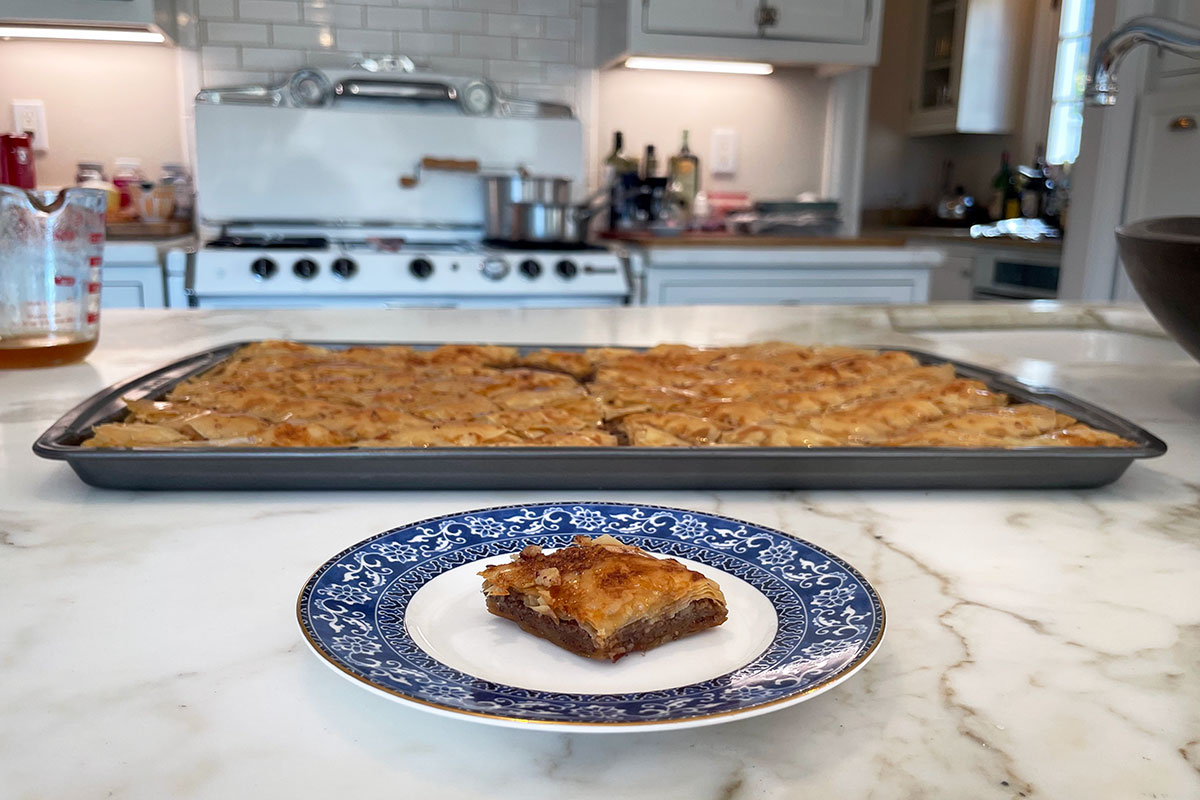The most hotly contested topic in my household is not current events or the greatest band of all time. It’s the cultural heritage of baklava, the layered pastry dish whose earliest ancient origins are unknown. If you ask my Assyrian mother and my half-Greek father, they’ll tell you their respective ancestral empires created baklava, and that any other notion is outlandish. It even comes down to how we say it: my younger brother, siding with my father, pronounces it as BAK-lah-va, and I, siding with my mother, say bak-LAH-va.
In moments like these, I’m obligated to choose my Assyrian heritage; I’m named after my Assyrian grandmother—my nani—whose American name was Bela. In Assyrian, an Aramaic language like Hebrew, ana quite literally means “I am.”
For me, growing up as part of an immigrant diaspora has meant finding ways to connect to my culture beyond a physical space. Assyrians—the same Assyrians of ancient Mesopotamia and the hanging gardens of Babylon, as I once proudly told my fourth-grade history class—don’t have a country and today exist largely in villages across the Middle East and centralized hubs in the United States and Europe. My nani was from a village outside of Tehran, Iran, called Mushawa, and her husband grew up in Baghdad, Iraq. Both left under conditions they could not return to, and so in the absence of a safe ancestral homeland to explore, I turn to food to remind myself where I come from.



My grandmother passed away last October at the age of eighty-nine. She was a remarkable woman, and the service was full of Assyrians from all over Northern California, because in a diasporic community so far displaced from our homeland, we always show up for our own. At the reception, tables of Assyrians laughed and cried over dolma, kibbe, ghormeh sabzi, kabab, rice, and, of course, baklava.
I believe baklava is a food for all seasons, but when the holidays come around and we remember our loved ones, there’s nothing quite like a cup of black tea brewed in a samovar and a sweet, flaky bite of baklava.
Bela’s Baklava

Ingredients
1 package of phyllo (filo) dough
Filling
3 cups nuts, ground (walnut, pistachio, or a mix)
3/4 cup sugar
1/2 teaspoon cinnamon
1 teaspoon cardamom
1/4 teaspoon nutmeg
Syrup
1/2 cup sugar
1 tablespoon lemon juice
3/4 cup water
1 1/4 cup honey
4 slices lemon
4 slices orange
2 cinnamon sticks
Topping
1/2 cup canola oil
1 cup unsalted butter
Preparation
First, prepare each of the components. Mix the filling ingredients together and set aside. In a pot, bring the syrup ingredients to a boil and let rest. In another pot, heat the topping ingredients until liquified.
To make the baklava, you will need a large baking pan at least a 1/2 inch deep. Preheat oven to 325 degrees Fahrenheit.
Lay a third of the phyllo dough flat in the pan. Most packages come with 18 sheets of phyllo, so each layer will have 6 sheets. Then, spread half of the filling mixture on top.
Lay another third of the phyllo dough on top of the filling. Lay the other half of the filling mixture on top. Cover with the final third of the phyllo dough.




Cut the layered phyllo into diagonal shapes. Pieces should be 1 to 2 inches in size.
Pour the heated topping over all the pieces. Don’t drench the phyllo—it should just cover it lightly, and there may be extra topping leftover.
Bake for 30 minutes until golden brown.
Remove from the oven and pour the syrup into sliced areas. There can be some syrup “sitting” on the bottom as it soaks up as the baklava cools.For the best flavor, let the baklava sit overnight, loosely covered, before eating with a warm cup of (unsweetened) black tea!

Annabella Hoge is a marketing intern at Smithsonian Folkways Recordings and an intern alum from the 2022 Folklife Festival. She is, in no particular order, a Dodgers fan, Georgetown grad, Goodreads fiend, and disco enthusiast.


